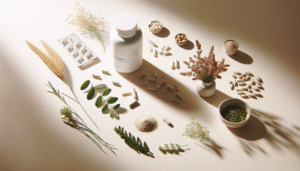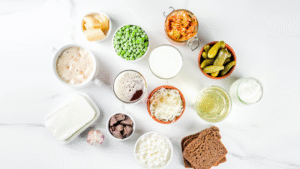Iron supplements beyond pregnancy may not get enough attention, but for women over 40, they can play a key role in energy, focus, and overall health. While many think of iron as mainly important during pregnancy, the truth is that midlife women are still at risk for deficiency.
Introduction
Iron supplements beyond pregnancy deserve a closer look. Women often associate iron with pregnancy or heavy menstrual cycles, but iron remains critical well into midlife. By the time women reach their 40s, shifts in hormones, changing menstrual patterns, and dietary choices can all affect iron levels. Fatigue, brain fog, brittle nails, and even restless legs are subtle signs that iron may be running low.
In this article, we’ll explore why iron matters beyond pregnancy, how much women really need, the difference between food and supplements, and the best strategies for maintaining healthy levels during perimenopause and beyond.
Why Iron Still Matters After Pregnancy
Iron carries oxygen in the blood and supports energy, brain health, and immunity. Without enough iron, women may feel constantly tired, dizzy, or weak, even if they are eating well and sleeping enough. Iron deficiency is still common among women in their 40s, especially those with heavy or irregular cycles in perimenopause. Even after menopause, iron needs remain—just at slightly lower levels—as the body continues to use iron for vital functions.
For women following plant-based diets, the risk of deficiency can be higher. Non-heme iron, the type found in plants, is absorbed less efficiently than heme iron from animal sources. Without careful planning, midlife women can fall short of daily needs, increasing their risk of anemia and its long-term effects.
Symptoms of Low Iron in Midlife Women
Iron deficiency doesn’t always announce itself loudly. Instead, the symptoms are often mistaken for aging or menopause. These can include:
- Fatigue that doesn’t improve with rest
- Difficulty concentrating or memory lapses
- Brittle nails or hair shedding
- Shortness of breath or palpitations
- Restless legs at night
Because these symptoms overlap with other midlife changes, it’s important to test ferritin levels (a marker of iron storage) before assuming deficiency. Still, recognizing the subtle signals can help women seek support earlier.
How Much Iron Do Women Over 40 Need?
The recommended dietary allowance (RDA) for iron depends on menopausal status. Women aged 19–50 generally need 18 mg per day, while postmenopausal women need about 8 mg per day. However, requirements can vary. Women with heavy cycles, fibroids, or low dietary intake may need more.
Blood tests are the only reliable way to assess iron status. If levels are low, a supplement may be prescribed. Taking more than needed, however, can cause digestive issues or even organ strain, so dosing should be individualized.
Food Sources of Iron
Iron comes in two forms: heme (from animal products) and non-heme (from plants). Both are valuable, but heme iron is more readily absorbed. Here are some sources to focus on:
- Heme iron: lean red meat, chicken, turkey, and seafood like clams and oysters
- Non-heme iron: beans, lentils, spinach, pumpkin seeds, quinoa, and tofu
Vitamin C improves iron absorption, so pairing iron-rich foods with citrus, berries, or bell peppers can boost intake. On the other hand, tea, coffee, and high-calcium foods can reduce absorption, so it’s best to separate them from iron-rich meals.
Iron Supplements: What Women Should Know
When diet alone isn’t enough, supplements can help restore healthy levels. Common forms include:
- Ferrous sulfate: widely used, affordable, but may cause stomach upset. Buy on Amazon.
- Ferrous gluconate: gentler on digestion. Buy on Amazon.
- Heme iron polypeptide: highly absorbable and effective, though less common. Buy on Amazon.
Women often tolerate newer formulations better, such as slow-release capsules or liquid iron. Choosing the right form can make supplementation easier and more consistent.
Practical Tips for Better Iron Absorption
- Take iron with vitamin C for best absorption
- Avoid pairing iron with coffee, tea, or dairy
- Try smaller, divided doses to reduce digestive upset
- Pair iron supplements with magnesium or fiber if constipation is an issue
By applying these small adjustments, women can maximize the benefits of their supplements without uncomfortable side effects.
Frequently Asked Question
1. Do women still need iron supplements after menopause?
Yes, though in smaller amounts. Iron remains essential for brain health, energy, and immunity, even when menstrual cycles stop.
2. Can too much iron be harmful?
Yes. Excess iron can accumulate and damage organs. Always test ferritin and consult a healthcare provider before starting high-dose supplements.
3. What’s the best way to know if I’m iron deficient?
A blood test measuring ferritin and hemoglobin is the most reliable way. Symptoms alone aren’t enough for diagnosis.
A Word From Vitamins For Woman
Iron supplements beyond pregnancy are not just for expectant mothers. They remain a cornerstone of women’s health well into midlife, supporting energy, focus, and resilience. Whether through food, supplements, or a combination, maintaining healthy iron levels is an act of self-care that strengthens your future. You deserve to feel vibrant and supported at every stage of life.
References
- McLean E, Cogswell M, Egli I, Wojdyla D, de Benoist B. Worldwide prevalence of anaemia, WHO Vitamin and Mineral Nutrition Information System, 1993–2005. Public Health Nutr. 2009;12(4):444-454.
- Short MW, Domagalski JE. Iron deficiency anemia: Evaluation and management. Am Fam Physician. 2013;87(2):98-104.
- Cepeda-Lopez AC, Osendarp SJ, Melse-Boonstra A, et al. Sharpening the double-edged sword of iron: Redefining strategies to combat iron deficiency anemia. Lancet Haematol. 2015;2(8):e364-e371.
- Miller JL. Iron deficiency anemia: A common and curable disease. Cold Spring Harb Perspect Med. 2013;3(7):a011866.
- Tolkien Z, Stecher L, Mander AP, Pereira DI, Powell JJ. Ferrous sulfate supplementation causes significant gastrointestinal side-effects in adults: A systematic review and meta-analysis. PLoS One. 2015;10(2):e0117383.







